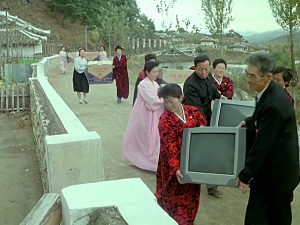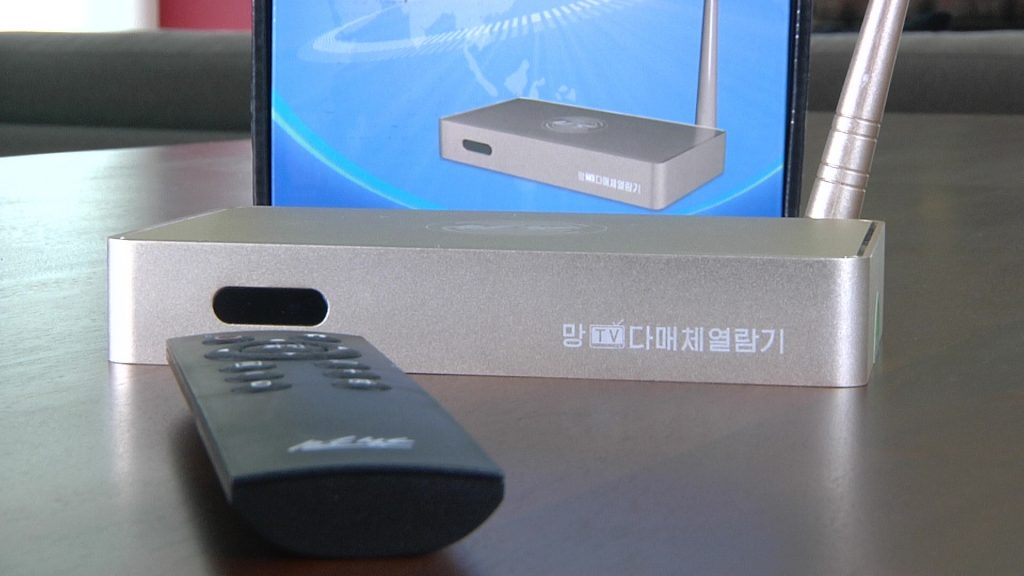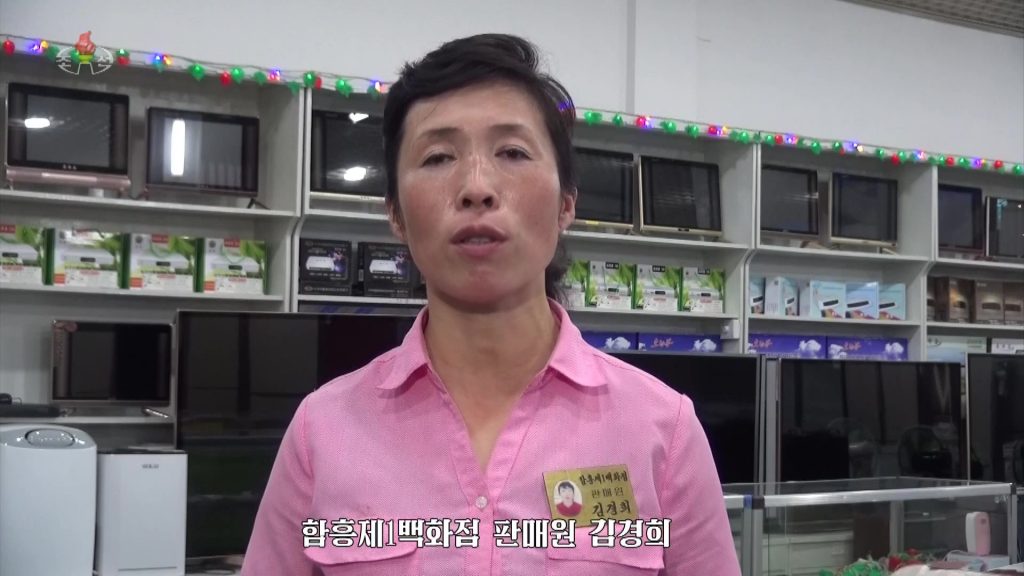North Korea’s Multi-Channel TV Age

North Korea has experienced something of a TV revolution over the last five years. While most of the country had previously only received a single channel, multi-channel television is now spreading beyond Pyongyang into the provinces. The three additional channels, available by digital broadcast and streaming, offer viewers in these areas something they’ve never had before from state television: choices. Combined with gradual changes at Korean Central Television (KCTV), the new channels can be seen as an attempt to make state media more attractive in the face of competition from illicit foreign content.
Additional Hardware Required
To receive the additional channels, viewers need a digital television or set-top box. North Korea began experimenting with digital TV in 2012 in Pyongyang, and in the last few years, the service has been spreading nationwide, according to state media.
The country uses the digital video broadcasting-second generation terrestrial (DVB-T2) standard, which is popular in much of the world but, crucially, isn’t used in China or South Korea. That means North Korean digital TVs won’t be able to receive broadcasts from neighboring countries—something that is currently a problem for authorities in the northern and southern border regions.
The four channels are also available on the Manbang streaming TV service, which is received in homes via a set-top box connected to the national intranet. There also appears to be a streaming app available on tablet PCs.

The set-top boxes for the service are available in stores. An August report on KCTV featured the No. 1 Department Store in Hamhung, and four models of set-top boxes could be seen for sale on the shelves behind an interviewee.

The boxes are also offered on subscription to homes, according to a report from Asia Press (Rimjingang). It said homes are offered a set-top box for 6,000 North Korean won per year (USD $7 at the official rate), collected in monthly installments. A box can be purchased outright for around 22,000 North Korean won (USD $24 at the official rate).
So, what’s on TV?[1]
Korean Central Television
Korean Central Television is the most familiar face of North Korean TV. It’s the primary channel that carries news, propaganda and ideology to the entire nation. KCTV began broadcasting on March 3, 1963, and since August 1999 has been available outside of the country via satellite. For many years, it was the only TV channel available to most North Korean citizens.
A typical day’s programming airs from 3 p.m. to around 10:30 p.m. daily, except for Sundays and the 1st, 11th and 21st of each month when programs begin at 9 a.m. On major national holidays, programs start at 8 a.m. The main news bulletin of the day is broadcast at 8 p.m. with additional bulletins at 5 p.m. and around 10:30 p.m.
KCTV Programming Guide – Saturday, September 7, 2019
15:00 Opening (Song of General Kim Il Sung, Song of General Kim Jong Il)
15:19 Report – Glorious History, Shining Tradition: Visiting the Museum of Korean Revolution
15:26 DPRK Science Movie – Multi-Purpose Compound Construction Material
15:47 Local Broadcast – Pumped Up by Struggle to Increase Production
15:52 Local Broadcast – Heightening Pride of Mine Workers
16:01 Beloved Supreme Leader Kim Jong Un’s Unprecedented Classical Work: Speech Delivered to the Participants of the 14th Teachers’ Conference
16:31 Introductory Compilation – Passionate Hearts Dedicated to Educational Services
17:00 News
17:21 Children’s Broadcasting Time – Korean Children’s Movie: A Mirror Given by Grandpa
18:00 Korean Documentary Film – In People’s Bosom for Eternity (5)
19:10 Beloved Supreme Leader Kim Jong Un’s Unprecedented Classical Work: Speech Delivered to the Participants of the 14th Teachers’ Conference
19:42 Introductory Compilation – Future That Cannot be Even Bought by Millions of Gold
20:00 News
20:23 Tomorrow’s Weather
20:47 Recorded Play – FIFA 2022 World Cup Asian Qualifier Game 2: DPRK – Lebanon
22:17 Among Today’s News
The first broadcast often covers some aspect of Korean history, and children’s shows are usually featured after a 5 p.m. news bulletin. It is also common to feature broadcasts about Kim Jong Un, sometimes multiple times, with small features on science, feats of progress in North Korea and revolutionary tales filling the rest of the time. Since 2019, soccer has been a more common offering, although the games are edited and broadcast on a delay. (KCTV has aired live soccer only once: the 2010 World Cup match against Portugal after an impressive performance in the first round against Brazil.)
Ryongnamsan TV
Ryongnamsan TV took to the air on September 5, 2012, replacing the Korean Educational and Cultural TV channel. This station has been available in Pyongyang since 1997 when it took over from Kaesong TV, which started in 1971. The channel was launched to cater to university students and carries educational programming as well as movies in English, Russian and Chinese.
Ryongnamsan TV began airing three days a week: from 7 p.m. to 10 p.m. on Mondays, Wednesdays and Fridays. In TV guides from 2019, it appears that it has expanded its broadcasts to five days a week, from 6 p.m. until around 10 p.m.
Ryongnamsan TV Programming Guide – Monday, November 18, 2019
18:00 Opening (Song of General Kim Il Sung, Song of General Kim Jong Il)
18:15 Scientific Technology Information – Formation of a Volcanic island (1)
18:22 Scientific Technology Information – The Earth and Organisms (1)
18:38 Medical Science Information – A Bean Good for Longevity, Adipocyte Stem Cell Used to Cure a Disease
18:44 Foreign Language Study Time – The Deepest Place on Earth (1)
19:03 General knowledge – Meaning of Landscape Painting and its Emotionality
19:12 Special – Apple Tasting in Pukchong
19:31 Scientific Technology Information – Passenger Coach Painting
19:38 Scientific Technology Information – Seawater Desalination Plant Construction
19:52 Scientific Technology Information – Potato Harvester, Potato Sorter
20:00 News
20:15 Tomorrow’s Weather
20:26 Great Leader Comrade Kim Il Sung’s Memoir – Reminiscences: With the Century, Episode 426
20:39 Question & Answer – Essence and Characteristics of a Socialist Law-Governed State
20:49 Introductory Compilation – Education and Science Technology
21:01 General Knowledge – Courtesy/Ethics at School: Greeting Manners Toward a Teacher
21:12 Scientific Technology Information – Water Resources Regeneration Process
21:21 Scientific Technology Information – Radiation Treatment by Electron Linear Accelerator, Production of Three-Wheelers
21:31 Scientific Technology Information – Mobile Home
21:36 General Knowledge – Optimization
21:44 Foreign Language Study Time – The Earth, High Mountains (4)
Most of the programming is filled with science and technology vignettes of the kind sometimes seen on KCTV. The station usually introduces the subject and explains the basic scientific principles behind it. It often features examples of the subject from within North Korea but does also use foreign footage to illustrate the work taking place.
Foreign language programs are also broadcast. One notable feature of the broadcast is that it relays the main evening news and weather broadcast from KCTV at 8 p.m., followed immediately by revolutionary education. In the example given, the educational piece is an episode of Kim Il Sung’s memoir. The same program has been broadcast on KCTV, but not since 2012.
Mansudae TV
Mansudae TV has been available on weekends in Pyongyang since it began broadcasting on December 4, 1983.[2] It has been described as an arts and culture channel, although it recently added sports programming to the mix. Historically, the station has been broadcast only on Saturdays and Sundays, but a 2019 TV schedule shows programming on Fridays as well. Its new broadcast hours appear to be Fridays and Saturdays from 7 p.m. to around 10 p.m., and Sundays from 10 a.m. to 1 p.m. and 4 p.m. to 10 p.m.
Mansudae TV Programming Guide – Saturday, September 7, 2019
19:00 Opening (Song of General Kim Il Sung, Song of General Kim Jong Il)
19:00 Physical Education Information – Athletes Who Enjoy Eating Traditional Cuisine
19:16 Physical Education (Athletic) Special – 2018-2019 English Premier League Game 10
19:36 International Information – People Along the Coast Benefitting from Virtues of the Forest
19:48 Chinese Artistic Movie – Banquet at Hongmen
Sports Television
North Korea’s newest TV channel is Sports TV. The channel started airing on August 15, 2015, and broadcasts on Saturday and Sunday evenings from 6 p.m. to around 10 p.m. In this respect, it fills the evenings when Ryongnamsan TV is not on the air.
Sports TV Programming Guide – Saturday, September 7, 2019
18:00 Opening (Song of General Kim Il Sung, Song of General Kim Jong Il)
18:12 Recorded Play – Men’s Hwabul Cup, Semi-Final
19:00 Information – Creation and Development of Artistic Gymnastics
19:04 Introductory Compilation – Korean People’s Traditional Martial Arts Taekwondo (3)
19:12 Recorded Play – FIFA 2019 Women’s World Cup Games, Round of 16
20:00 News
20:15 Tomorrow’s Weather
20:30 Recorded Play – 2019 IIHF Ice Hockey World Championship Ice Hockey Games
21:12 Athletic Anecdotes – Olympics Anecdotes (5) – The Shining Star of African Track and Field
21:16 Recorded Play – 2019 Copa America Soccer Games
Sports TV appears to broadcast several sports events all day, all edited down from their original length. For the broadcasts on September 7, 2019, all of the foreign soccer matches are at least two months old.
Domestic sports coverage is timelier. The Hwabul Cup, for instance, is North Korea’s domestic soccer tournament, and the match listed on the program guide took place only two days earlier.
Interestingly, the TV guide notes those broadcasts are recorded, perhaps suggesting that occasional live coverage is shown. It is also curious why, given the large amount of time the TV station is not on the air, more time isn’t given to air the various matches and games in full.
Conclusion
The spread of digital TV to the provinces helps the state demonstrate technological progress, which is a key message in Workers’ Party propaganda. The additional channels are a useful vehicle for spreading widely news, scientific knowledge and political education, while also providing some entertainment options. Perhaps the most important purpose for expanding TV programming for the masses is to provide some choice for North Korean viewers. While officially, there is no competition to state media, in reality, viewers are tuning away in favor of illicit foreign content. The expansion of TV choice is likely a first step towards countering this.
- [1]
The information in this report is based on TV schedules printed in North Korean newspapers obtained for four days in autumn 2019. To provide for comparison, the detailed schedules are presented for Saturday, September 7, 2019, when three of the channels are on air at the same time. The schedules are as presented in the newspaper and do not take into account late changes made to accommodate news about Kim Jong Un.
- [2]
Mansudae TV is widely reported to have begun broadcasting in 1973. That is apparently based on a report from People’s Korea newspaper in 2002, but it appears to be a typo. A BBC Monitoring report timestamped on the same date in 1983 reports on the start of broadcasts.
